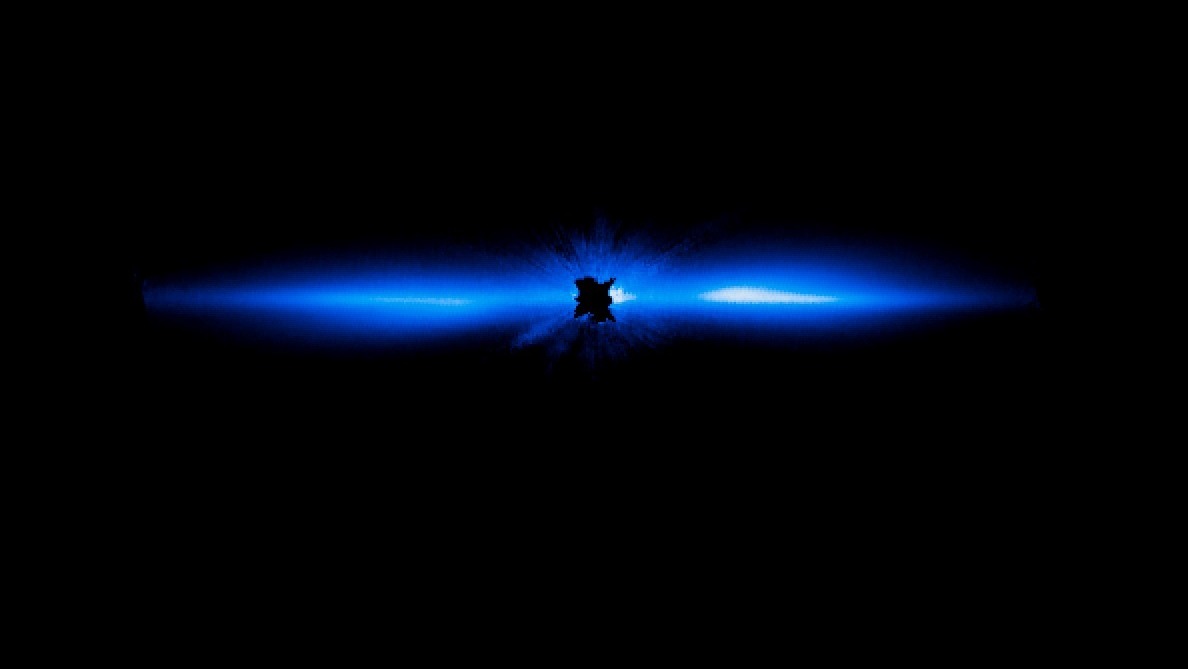James Webb Space Telescope will watch smashing worlds in high definition
The messy system of Beta Pictoris will come under scrutiny to learn how similar it is to our solar system.

Researchers are looking forward to a glimpse of colliding worlds in action from NASA's cutting-edge space observatory.
After the James Webb Space Telescope finishes its commissioning period and releases its first operational images on July 12, the observatory will dive into science in earnest. And one of the telescope's first-year investigations will include a close-up view of the strange neighborhood of Beta Pictoris.
The young star, just 63 light years away from us, is surrounded by a dusty disc full of debris left over from its formation. It's a crowded space, hosting "at least two planets [and] a jumble of smaller, rocky bodies," researchers said in a 2021 press release about the investigation.
Live updates: NASA's James Webb Space Telescope mission
Related: How the James Webb Space Telescope works in pictures
While the research has numerous directions, one key aspect is watching a young planetary system evolving as planetesimals (the predecessors to planets) collide. Because Beta Pictoris is wreathed in dust, researchers will be using Webb's infrared light to peer through the debris and see what is happening in high definition.
Webb will have decades of past work to draw upon, including ground-based observatories and space observations from the Hubble Space Telescope. We know from such studies that Beta Pictoris hosts at least two gigantic planets, both much more massive than Jupiter. Researchers also glimpsed the first known exocomets, or comets beyond our solar system, whirling in the debris cloud.
But it's the debris disk that is exciting researchers, as Webb will be able to look through the dust to potentially see the effects of collisions between asteroids, comets, planetesimals and other small bodies. Even pebbles and boulders in the outer debris disc, the press release stated, could generate enough dust for Webb to see.
Breaking space news, the latest updates on rocket launches, skywatching events and more!
Two investigations are planned in Webb's first set of observations, known as Cycle 1. A team led by Chris Stark, a postdoctoral program fellow at NASA's Goddard Space Flight Center in Maryland, will use a coronagraph (star-blocking device) to observe the debris disc in more detail.
The research aims to answer key questions about how similar this system is to the Milky Way. For example, Stark's team hopes to trace how dust and water ice in the outer belt of the debris cloud migrates in to the inner reaches.
Dust will also be studied as a pathfinder to finding comets and asteroids embedded in the thick cloud. Researchers will gain information about the spectrum, or pattern of elements found in the dust, by focusing on how warm dust scatters or re-emits light. Such work will also be key to comparing Beta Pictoris to our solar system, by examining their relative abundance of gases and minerals.
The Stark team is creating models of Beta Pictoris in research led by Isabel Rebollido, a postdoctoral researcher at the Space Telescope Science Institute (STScI) that manages the scheduling of Webb science investigations.
Already the team has a model based on a range of data from past missions, spanning wavelengths including radio, near-infrared, far-infrared, and visible light. Once Webb captures its own investigations, the team will add its infrared work to the old model — while building a second model hosting only Webb's data.
The team is curious as to whether the light Webb observes is symmetrical, or hosts "bumps" in the data that would show dust accumulating in certain regions of Beta Pictoris.
"Webb is far more sensitive than any other space telescope, and gives us a chance to look for this evidence, as well as water vapor where we know there’s gas," Rebollido added in the same press release.
A second investigation, led by STScI associate astronomer Christine Chen, will study the dust left behind by colliding planetesimals. Chen's team is interested in learning what the smallest dust grains look like (whether fluffy, or compact), along with what the composition of these grains might be.
"Dust grains are 'fingerprints' of planetesimals we can't see directly, and [grains] can tell us about what these planetesimals are made of and how they formed," Chen said in the press release.
For example, researchers will seek to learn whether the planetesimals are rich in ice, like comets, or if the dust is more indicative of rocky worlds. They also will investigate a carbon monoxide cloud at the disc's edge that is oddly asymmetric.
"One theory is that collisions released dust and gas from larger, icy bodies to form this cloud. Webb's spectra will help them build scenarios that explain its origin," the STScI press release said of the research.
Follow Elizabeth Howell on Twitter @howellspace. Follow us on Twitter @Spacedotcom and on Facebook.

Elizabeth Howell (she/her), Ph.D., was a staff writer in the spaceflight channel between 2022 and 2024 specializing in Canadian space news. She was contributing writer for Space.com for 10 years from 2012 to 2024. Elizabeth's reporting includes multiple exclusives with the White House, leading world coverage about a lost-and-found space tomato on the International Space Station, witnessing five human spaceflight launches on two continents, flying parabolic, working inside a spacesuit, and participating in a simulated Mars mission. Her latest book, "Why Am I Taller?" (ECW Press, 2022) is co-written with astronaut Dave Williams.


